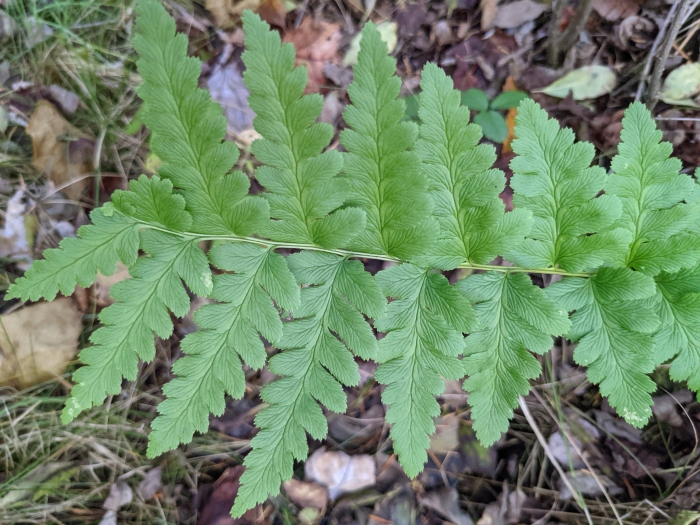Clinton’s Wood Fern
(Dryopteris clintoniana)
Clinton’s Wood Fern (Dryopteris clintoniana)
/
/

© Nick Kleinschmidt
CC BY 4.0
Image By:
© Nick Kleinschmidt
Recorded By:
Copyright:
CC BY 4.0
Copyright Notice:
Photo by: © Nick Kleinschmidt | License Type: CC BY 4.0 | License URL: http://creativecommons.org/licenses/by/4.0/ | Uploader: nick2524 | Publisher: iNaturalist |

























Estimated Native Range
Summary
Dryopteris clintoniana, commonly known as Clinton’s wood fern, is a perennial herbaceous plant and a fertile hexaploid fern of hybrid origin. It is native to the temperate regions of the northern hemisphere, specifically thriving in moist, shady forest environments, often in deciduous or mixed woodlands, and sometimes in swampy areas. This fern typically grows to a height of 30-90 cm (12-35 inches) and is characterized by its upright, arching fronds that are broadly triangular and bipinnate-pinnatifid, giving them a feathery appearance. The fronds are a rich, deep green color and are most lush during the summer months. Clinton’s wood fern does not produce flowers or seeds, but its spores are found on the underside of the fronds and are an important means of propagation.
Clinton’s wood fern is valued for its shade tolerance and lush foliage, making it an excellent choice for woodland gardens, shaded borders, and naturalized areas. It is relatively low-maintenance, requiring consistently moist soil and protection from strong winds. It prefers part shade to full shade and acidic to neutral soil with good organic content. While it is not typically afflicted by serious pests or diseases, it can suffer from root rot if the soil is too wet. This fern is not known to be invasive and does not have aggressive roots, making it a safe choice for cultivation near other plants.CC BY-SA 4.0
Clinton’s wood fern is valued for its shade tolerance and lush foliage, making it an excellent choice for woodland gardens, shaded borders, and naturalized areas. It is relatively low-maintenance, requiring consistently moist soil and protection from strong winds. It prefers part shade to full shade and acidic to neutral soil with good organic content. While it is not typically afflicted by serious pests or diseases, it can suffer from root rot if the soil is too wet. This fern is not known to be invasive and does not have aggressive roots, making it a safe choice for cultivation near other plants.CC BY-SA 4.0
Plant Description
- Plant Type: Fern
- Height: 4-5 feet
- Width: 2-3 feet
- Growth Rate: Moderate
- Flower Color: N/A
- Flowering Season: Non-Flowering
- Leaf Retention: Deciduous
Growth Requirements
- Sun: Part Shade
- Water: Low
- Drainage: Medium, Slow
Common Uses
Border Plant, Deer Resistant, Low Maintenance
Natural Habitat
Temperate regions of the northern hemisphere, specifically thriving in moist, shady forest environments, often in deciduous or mixed woodlands, and sometimes in swampy areas
Other Names
Common Names: Narrow-leaved Buckler Fern, Clinton’s Fern, Clinton’s Shield Fern
Scientific Names: , Dryopteris clintoniana, Aspidium clintonianum, Aspidium cristatum var. clintonianum, Dryopteris clintoniana var. genuina, Dryopteris cristata var. clintoniana, Dryopteris ×poyseri, Filix cristata var. clintoniana, Filix-mas cristata var. clintoniana, Nephrodium clintonianum
GBIF Accepted Name: